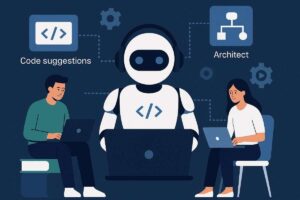few years ago, the idea of AI writing meaningful code felt like science fiction. Today, it’s an everyday reality for developers across the globe.
At ForkPoint, we’ve always embraced innovation – AI has become one of the most powerful tools in our development toolbox. It’s not just about speed—it’s about writing clean, maintainable code without compromising on quality, solving real problems with clarity, and delivering smarter, more efficient solutions for our clients.
Here’s how AI has transformed the way we build software at ForkPoint.
We Skip the Boilerplate and Get to the Real Work
There’s nothing inspiring about writing the same setup code over and over again. API endpoints, routing layers, state management boilerplate—it’s necessary, but it doesn’t move the needle.
That’s why we use AI tools like GitHub Copilot, Windsurf, and Cursor to handle the heavy lifting. With just a few lines of instruction, we can generate full modules and configurations, freeing us up to focus on what actually matters: the business logic, the architecture, and the user experience.
“Time saved on setup and edge cases means more time for real logic.”

AI coding tools have gone mainstream. Over 90% of developers now use some form of AI in their daily workflows. The most popular tools offer more than just code suggestions—they’re collaborative assistants, architects, and even partial automation agents.
We Deliver Better Quality Code—Faster ⚡
Testing used to be the part of the process that got pushed aside under tight deadlines. But not anymore.
Now, with AI-assisted tools, we generate comprehensive test coverage as we go—unit tests, integration tests, even complex edge-case scenarios. We’ve integrated this into our CI pipelines so that AI helps us write better code and catch more bugs before they reach production.
It’s a win-win: higher quality software, delivered faster.
Documentation Isn’t a Chore—It’s Built In
Proper documentation has long been an afterthought. Not anymore.
AI now auto-generates comments, README files, and API specifications as you code. This includes intelligent summaries of functions, endpoints, and business logic, formatted clearly for humans.
The result is a fully documented codebase that’s easier to maintain. Whether it’s for our clients or our team, this means everyone has up-to-date, readable documentation—without having to dig through code or write it all manually.
Debugging with AI – More Context, Less Guesswork 🐞
Stuck on a bug? We use tools like Copilot Chat, Cursor, and ChatGPT to help us interpret error messages, suggest possible causes, and surface known solutions from similar problems.
These tools don’t solve the issue for us—but they do help reduce the time spent guessing, especially when we’re facing vague stack traces or unclear logs. Instead of manually combing through forums or documentation, we can get a quick explanation, a list of possible fixes, or even a code snippet that points us in the right direction. It’s not magic—but it often saves time, especially on smaller or well-known issues.
Emerging Trends in Developer AI 📈
Several key trends are defining how developers use AI today:
1. Vibe Coding
Developers describe what they want (“a user signup flow with email validation and success message”), and the AI generates the code. Tools like Cursor and Copilot Chat are pioneering this approach.
2. Full-Stack AI Orchestration
AI can now coordinate frontend and backend updates simultaneously. Describe a feature, and it builds React components, APIs, DB schemas, and tests—all at once.
3. Multi-Agent Collaboration
Some platforms now use multiple AI agents that work together: one builds the feature, another tests it, another documents it. Developers supervise the process, rather than managing every line.
4. AI for Code Understanding
AI assistants are becoming invaluable for onboarding into large, unfamiliar codebases. Ask a question in plain language — “Where is the payment logic handled?” — and the AI guides you to the answer.
What This Means for Developers
This isn’t the end of human coding—it’s the beginning of a smarter, faster, more collaborative era.
- Junior developers can get up to speed faster.
- Senior developers spend more time on architecture and strategy.
- Teams ship higher-quality products with tighter feedback loops.
The developer’s role is shifting — from executing every detail to shaping, reviewing, and steering intelligent systems that help build the code with them.
We Stay Ahead by Staying Curious 🔍
We see AI as a partner that enhances our work, not something that replaces effort. It doesn’t replace our skills or creativity—it amplifies them.
Whether we’re building complex enterprise platforms, e-commerce systems, or innovative AI-driven products for our clients, we use AI to accelerate delivery, reduce errors, and improve collaboration.
And because we’re constantly exploring new tools and methods, we stay ahead of the curve—so our clients do, too.
Let’s Build Something Smarter—Together
We don’t just follow trends—we build with them. Our team leverages the latest AI tools and workflows to deliver smarter and more scalable digital solutions for our clients.
From improving product catalogs to optimizing customer journeys, we use AI to help e-commerce brands move faster, reduce costs, and stay competitive in a rapidly evolving market.
👉 If you’re looking for a development partner who works fast, thinks clearly, and uses the right tools for the job, get in touch – our experts are here to help!



